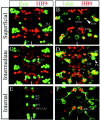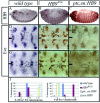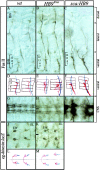Drosophila HB9 is expressed in a subset of motoneurons and interneurons, where it regulates gene expression and axon pathfinding
- PMID: 12417636
- PMCID: PMC6758048
- DOI: 10.1523/JNEUROSCI.22-21-09143.2002
Drosophila HB9 is expressed in a subset of motoneurons and interneurons, where it regulates gene expression and axon pathfinding
Abstract
Motoneurons are an essential component of all metazoan nervous systems, but it is unknown whether there is an evolutionarily conserved mechanism for generating motoneurons during neurogenesis. In the vertebrate CNS, HB9/MNR2 transcription factors are specifically expressed in all somatic motoneurons and are necessary to distinguish motoneurons from interneurons, in part by repressing interneuron-specific gene expression. Here, we identify and characterize the single Drosophila ortholog of the HB9/MNR2 gene family. Drosophila HB9 is detected in a subset of motoneurons with ventral muscle targets and in a small group of interneurons, including the well characterized serotonergic interneurons. RNA interference knockdown of HB9 levels leads to defects in motoneuron ventral muscle target recognition, ectopic expression of a marker for dorsally projecting motoneurons (Even-skipped), and defects in serotonergic interneuronal projections. Conversely, ectopic HB9 expression causes an expansion of ventral motoneuron projections and repression of Even-skipped. Thus, Drosophila HB9 is required in a subset of motoneurons and interneurons for establishing proper axon projections but does not have a general role in distinguishing motoneuron and interneuron cell types.
Figures




Similar articles
-
dbx mediates neuronal specification and differentiation through cross-repressive, lineage-specific interactions with eve and hb9.Development. 2009 Oct;136(19):3257-66. doi: 10.1242/dev.037242. Epub 2009 Aug 26. Development. 2009. PMID: 19710170 Free PMC article.
-
Specification of Drosophila aCC motoneuron identity by a genetic cascade involving even-skipped, grain and zfh1.Development. 2006 Apr;133(8):1445-55. doi: 10.1242/dev.02321. Epub 2006 Mar 15. Development. 2006. PMID: 16540509
-
The Drosophila islet gene governs axon pathfinding and neurotransmitter identity.Neuron. 1997 Mar;18(3):397-409. doi: 10.1016/s0896-6273(00)81241-6. Neuron. 1997. PMID: 9115734
-
The acquisition of motoneuron subtype identity and motor circuit formation.Int J Dev Neurosci. 2001 Apr;19(2):175-82. doi: 10.1016/s0736-5748(00)00090-3. Int J Dev Neurosci. 2001. PMID: 11255031 Review.
-
Cellular and molecular bases of axonal pathfinding during embryogenesis of the fish central nervous system.J Neurobiol. 1999 Jan;38(1):137-60. doi: 10.1002/(sici)1097-4695(199901)38:1<137::aid-neu11>3.0.co;2-p. J Neurobiol. 1999. PMID: 10027569 Review.
Cited by
-
A transcription factor network coordinates attraction, repulsion, and adhesion combinatorially to control motor axon pathway selection.Neuron. 2014 Mar 19;81(6):1297-1311. doi: 10.1016/j.neuron.2014.01.038. Epub 2014 Feb 20. Neuron. 2014. PMID: 24560702 Free PMC article.
-
Growth at Cold Temperature Increases the Number of Motor Neurons to Optimize Locomotor Function.Curr Biol. 2019 Jun 3;29(11):1787-1799.e5. doi: 10.1016/j.cub.2019.04.072. Epub 2019 May 23. Curr Biol. 2019. PMID: 31130453 Free PMC article.
-
Coe genes are expressed in differentiating neurons in the central nervous system of protostomes.PLoS One. 2011;6(6):e21213. doi: 10.1371/journal.pone.0021213. Epub 2011 Jun 17. PLoS One. 2011. PMID: 21695052 Free PMC article.
-
Genome-wide identification of Drosophila Hb9 targets reveals a pivotal role in directing the transcriptome within eight neuronal lineages, including activation of nitric oxide synthase and Fd59a/Fox-D.Dev Biol. 2014 Apr 1;388(1):117-33. doi: 10.1016/j.ydbio.2014.01.029. Epub 2014 Feb 7. Dev Biol. 2014. PMID: 24512689 Free PMC article.
-
Strategies for delineating spinal locomotor rhythm-generating networks and the possible role of Hb9 interneurones in rhythmogenesis.Brain Res Rev. 2008 Jan;57(1):64-76. doi: 10.1016/j.brainresrev.2007.06.025. Epub 2007 Aug 14. Brain Res Rev. 2008. PMID: 17905441 Free PMC article. Review.
References
-
- Arber S, Han B, Mendelsohn M, Smith M, Jessell TM, Sockanathan S. Requirement for the homeobox gene Hb9 in the consolidation of motor neuron identity. Neuron. 1999;23:659–674. - PubMed
-
- Bellomonte D, Di Bernardo M, Russo R, Caronia G, Spinelli G. Highly restricted expression at the ectoderm-endoderm boundary of PIHbox 9, a sea urchin homeobox gene related to the human HB9 gene. Mech Dev. 1998;74:185–188. - PubMed
-
- Brand AH, Perrimon N. Targeted gene expression as a means of altering cell fates and generating dominant phenotypes. Development. 1993;118:401–415. - PubMed
-
- Broihier HT, Skeath JB. Drosophila homeodomain protein dHb9 directs neuronal fate via crossrepressive and cell-nonautonomous mechanisms. Neuron. 2002;35:39–50. - PubMed
-
- Campbell G, Goring H, Lin T, Spana E, Andersson S, Doe CQ, Tomlinson A. RK2, a glial-specific homeodomain protein required for embryonic nerve cord condensation and viability in Drosophila. Development. 1994;120:2957–2966. - PubMed
Publication types
MeSH terms
Substances
Grants and funding
LinkOut - more resources
Full Text Sources
Other Literature Sources
Molecular Biology Databases
